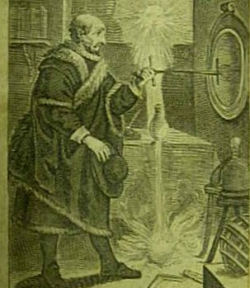Abū Bakr Muhammad ibn Zakariyyā al-Rāzī. Opera parva Abubetri filii Zacharie (1511). Classmark: SPEC CB.090/A
 Folio CCXXXVIII recto. Image from the Wellcome Collection.
Folio CCXXXVIII recto. Image from the Wellcome Collection.
Abū Bakr Muhammad ibn Zakariyyā al-Rāzī (also known as Rhazes or Rasis) (854 CE – 925 CE), was a Persian polymath, physician, alchemist, philosopher, and important figure in the history of medicine. A teacher, and early proponent of experimental medicine, he became a successful doctor, and served as chief physician of Baghdad and Rey hospitals. He was among the first to use humorism to distinguish between contagious diseases, and wrote a pioneering book about smallpox and measles. Translated by Gerard of Cremona, the Opera parva combines al-Razi’s al-Manșūrī (an encyclopaedia of practical medicine, derived largely from Greek sources) with several minor works. It also includes Constantinus Africanus’ Viaticum, in which love is characterized as a disease, similar to melancholy in its manifestations and its roots in humoral imbalance. (Source: The Arcadian Library Online)
More generally, al-Razi's ideas in alchemy centered around transmutation and chemical reactions.
___________________________________________________________________
 Jabir ibn Hayyan. Alchemiae Gebri Arabis philosophi solertissimi libri; cum reliquis (1545). Classmark: SPEC CB.093/A
Jabir ibn Hayyan. Alchemiae Gebri Arabis philosophi solertissimi libri; cum reliquis (1545). Classmark: SPEC CB.093/A
Known as the father of Arab Chemistry and one of the most famous Alchemists, Jabir ibn Hayyan "dedicated his work to the development of basic chemical methods using experimentation and the study of chemical reactions and their principles, thus paving the road for transforming chemistry from the realm of myths and legends to a scientific discipline".
"Jabir is credited with the introduction of experimental methodology into alchemy and the invention of several chemical processes used in modern chemistry. These include crystallization, calcinations, sublimation and evaporation, the synthesis of acids (hydrochloric, nitric citric, acetic and tartaric acids), and distillation using his greatest invention, the alembic (Anbaiq). Other achievements included preparation of various metals, development of steel, dyeing of cloth and tanning of leather, varnishing of water-proof cloth, use of manganese dioxide in glass-making, prevention of rusting, and identification of paints and greases. He also developed aqua regia to dissolve gold.
Jabir suggested three categories for the natural elements: Spirits, which vaporize on heating; metals like gold, silver, lead, iron and copper; and stones that can be converted to powder. This nomenclature could represent the beginning of more recent classifications of elements."
Many of his works were translated into Latin during the Middle Ages and the name Gerber was used for his works by Europeans. He died at the age of 94 in 815 AD.
(Source: Amr S.S. and Tabkhi A., 2007. 'Jabir ibn Hayyan' in Annals of Saudi Medicine, 27(1), pp. 53-54.)
Title page. Image from the Internet Archive, Getty Research Institute. A full digitised copy is available to view on Internet Archive.






 Folio CCXXXVIII recto. Image from the
Folio CCXXXVIII recto. Image from the  Jabir ibn Hayyan. Alchemiae Gebri Arabis philosophi solertissimi libri; cum reliquis (1545). Classmark:
Jabir ibn Hayyan. Alchemiae Gebri Arabis philosophi solertissimi libri; cum reliquis (1545). Classmark: 
 only work on the subject printed by the Aldine Press. The Aldine bibliograper Renouard evocatively notes that many copies of this book bear signs of fire damage, implying that the text was actually used in the attempt to turn base metals into gold. (Source:
only work on the subject printed by the Aldine Press. The Aldine bibliograper Renouard evocatively notes that many copies of this book bear signs of fire damage, implying that the text was actually used in the attempt to turn base metals into gold. (Source: 
 Crollius; the other III: Discovering the wonderfull mysteries of the creation by Paracelsus; both made English by H. Pinnell (1657). Classmark:
Crollius; the other III: Discovering the wonderfull mysteries of the creation by Paracelsus; both made English by H. Pinnell (1657). Classmark: 
